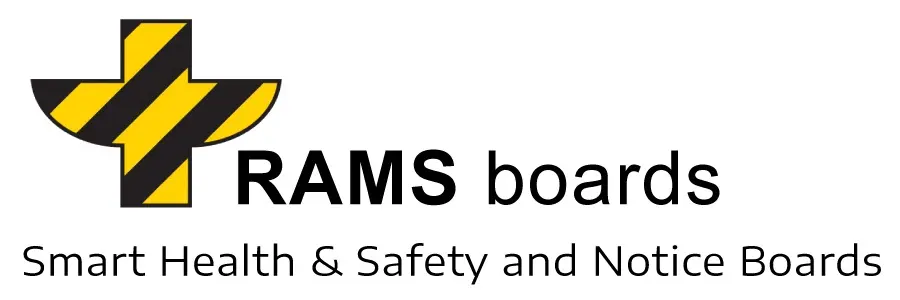Construction sites are often bustling with activity, and that energy can sometimes lead to danger. Ensuring the safety of workers and visitors isn’t just a priority—it’s non-negotiable. Enter the construction site safety board, a vital tool that serves as the central hub for all critical safety information. It’s not just about keeping things organized—it’s about creating a secure, efficient, and well-informed workplace.
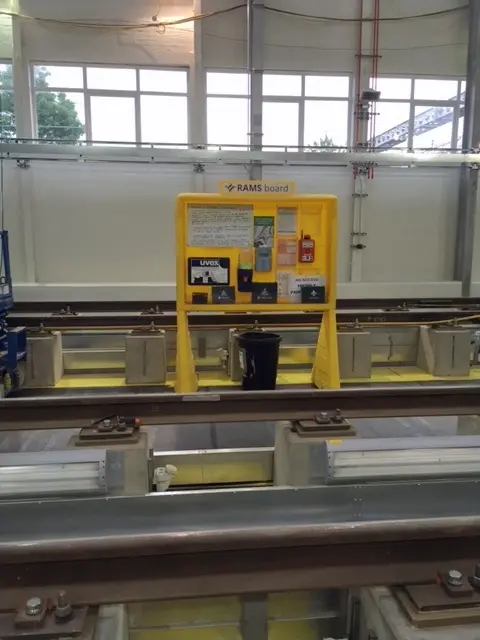
These boards are far from mere formalities.By offering clear, easily accessible safety instructions, they help minimize risks and prevent accidents. Whether you’re a seasoned professional or stepping onto the site for the first time, these boards ensure everyone understands the safety protocols and precautions in place.
The Risks of Operating Without a Safety Board
Imagine a construction site without a safety board. Workers might miss out on essential updates about new hazards or revised safety measures. Visitors could unknowingly enter restricted zones, endangering themselves and others. Without this centralized resource, the site’s safety framework could quickly fall apart, leading to confusion and unnecessary risks. And let’s face it—no one wants to deal with that kind of chaos.
Innovations in Safety Boards
As the construction industry evolves, so do the possibilities for enhancing safety boards. From sleek, modern designs to cutting-edge features like digital displays or QR codes linking to detailed guidelines, there’s plenty of room for innovation. These advancements don’t just make the boards more visually appealing—they actively engage everyone on-site, reinforcing a culture of safety and continuous improvement. It’s about staying vigilant and always striving to do better.
Understanding Construction Site Safety Boards
Construction sites are bustling hubs of activity, where safety must always take center stage. One of the most effective ways to ensure everyone’s well-being is through the use of construction site safety boards. Strategically positioned across the site, these boards deliver essential safety tips, warnings, and instructions, ensuring that both workers and visitors are well-informed about necessary precautions.
These boards act as the ultimate safety resource by centralizing critical information and making it easily accessible to everyone. This approach not only helps prevent accidents but also ensures compliance with health and safety regulations. The result? A safer, more efficient, and secure work environment for all.
For construction site managers, understanding the role of these boards is indispensable. They go beyond mere regulatory requirements, serving as a proactive tool to enhance safety awareness and foster a culture of vigilance across the site.
What Are Construction Site Safety Boards?
A construction site safety board is far more than just another sign—it’s a centralized hub for all safety-related information. These boards consolidate vital messages and regulatory details into a single, highly visible location. Designed to catch the eye, they ensure that everyone on-site can quickly grasp the safety protocols.
Typically, these boards include:
- Emergency contact numbers: Quick access to critical contacts in case of an incident.
- Site-specific rules: Guidelines tailored to the unique requirements of the site.
- Task-specific safety instructions: Clear directions relevant to ongoing activities.
By presenting this information in a clear and organized manner, these boards significantly reduce risks and encourage a culture of vigilance. Beyond information-sharing, they act as constant reminders that safety is a collective responsibility. They emphasize that protecting oneself also means looking out for others, fostering a sense of shared accountability. This collaborative approach helps create a more secure and attentive work environment.
Importance of Safety Boards on Construction Sites
On a construction site, safety boards are not optional—they’re essential. These boards form the backbone of health and safety compliance, safeguarding both workers and visitors from potential hazards.
By breaking down complex safety information into straightforward, actionable steps, these boards empower individuals to take the right precautions. They highlight potential dangers and provide practical advice, playing a crucial role in accident and injury prevention. This proactive strategy is vital for maintaining a safe work environment.
Key benefits of safety boards include:
- Accident prevention: Clear instructions and warnings help mitigate risks.
- Compliance assurance: Ensures adherence to health and safety regulations.
- Safety awareness: Reinforces a culture of vigilance and shared responsibility.
- Productivity boost: A safety-conscious team is often more efficient and successful.
As construction practices evolve, one pressing question remains: how can we leverage emerging technologies and innovative solutions to make safety boards even more effective? The goal is to continually push the boundaries of safety, ensuring that everyone on-site is as protected as possible.
Types of Construction Site Safety Boards
In the dynamic world of construction, safety boards are indispensable. They act as the silent guardians of the site, ensuring that everyone remains informed and protected. These boards are not merely about rules; they foster a culture of safety. Workers, visitors, and contractors rely on them to navigate precautions and procedures, ensuring smooth and secure operations. By exploring the various types of construction site safety boards, project managers can significantly enhance both safety and efficiency.
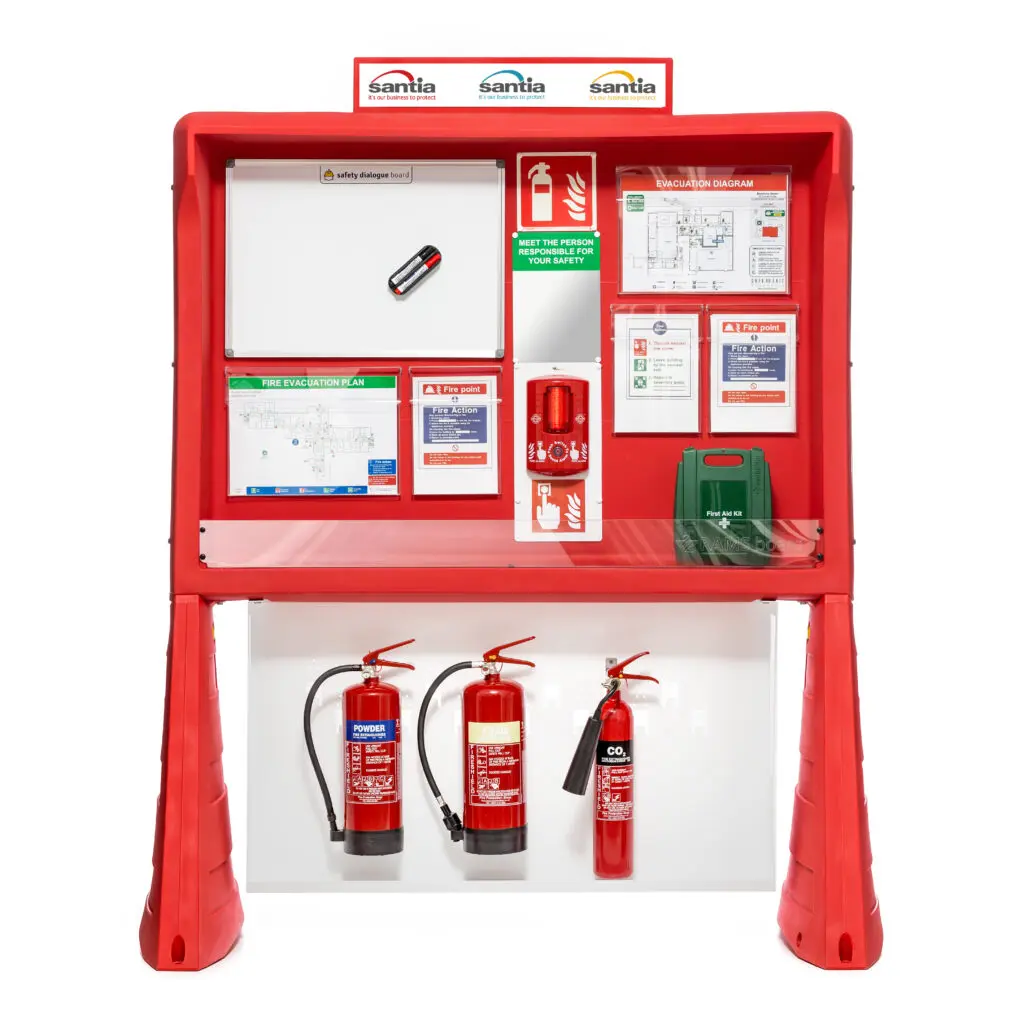
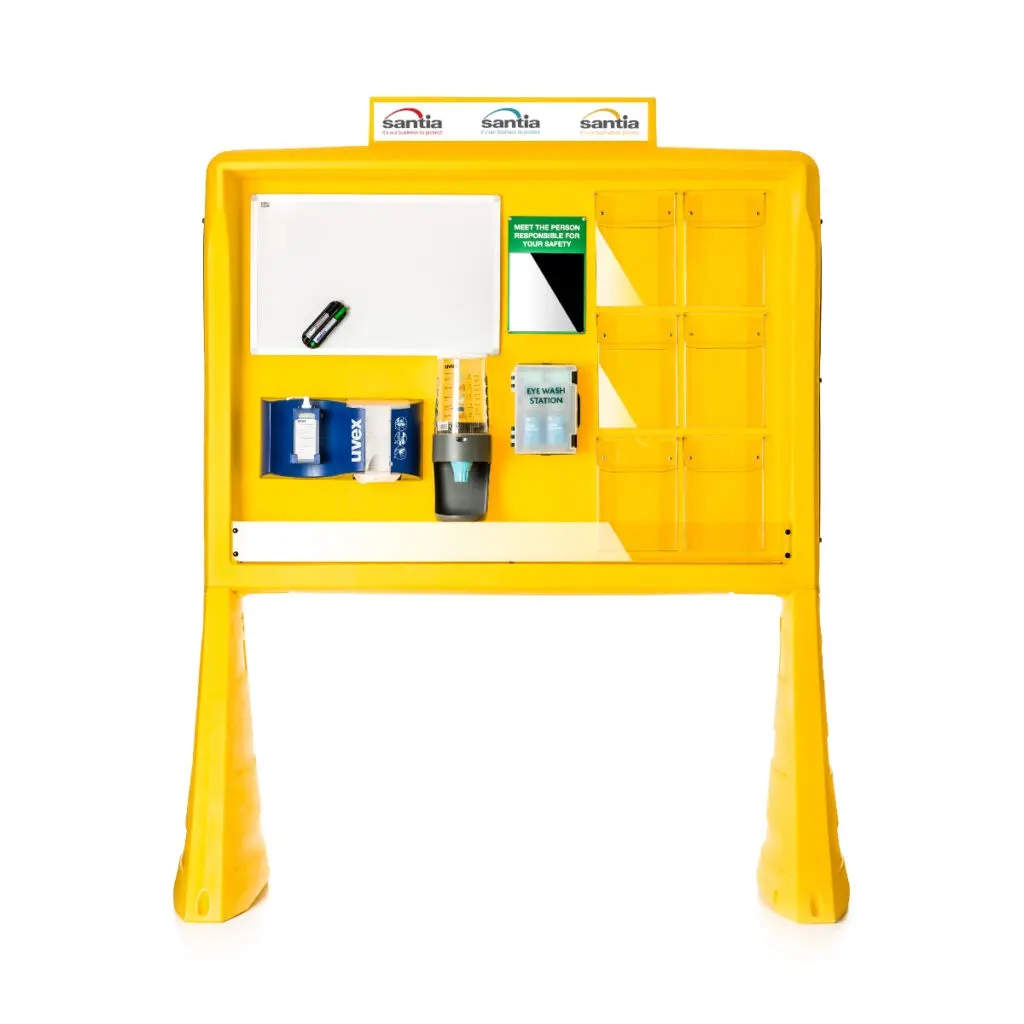
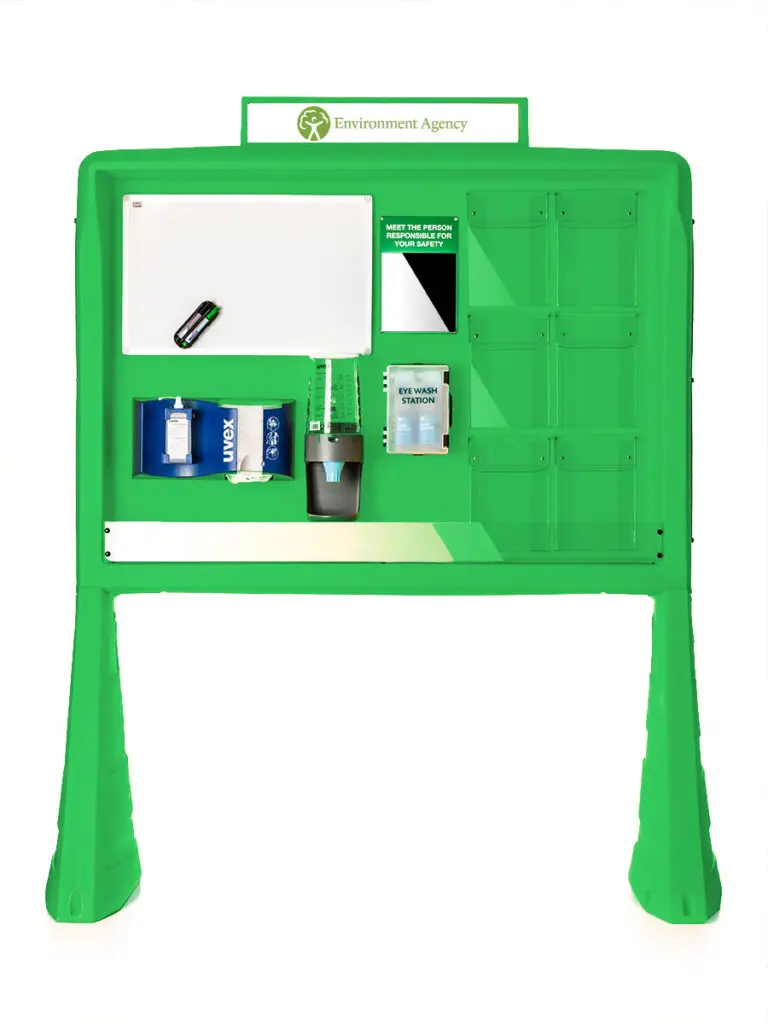
One prominent option is the custom site safety board. These boards serve as tailored safety hubs, reflecting your company’s branding while emphasizing specific safety protocols. Many come equipped with practical features like document holders or integrated first aid kits, making them both functional and versatile. Another effective solution is the multi-message board, which consolidates multiple warnings, instructions, and safety messages into a single, organized display. This approach minimizes confusion and ensures clear communication.
For sites that are constantly on the move, compact H&S info boards are invaluable. Lightweight and portable, these boards are ideal for dynamic environments. They often include first aid points and hygiene stations, making them essential for ever-changing workspaces. Lastly, the Safety Starts Here boards provide an all-in-one display that combines mandatory, warning, and prohibition signs in a single, accessible location, ensuring no critical safety detail is overlooked.
As construction sites grow increasingly complex, one key question arises: how can these boards be further customized to address the unique safety challenges of each project?
Customisable Site Safety Boards: Features and Benefits
Customisable site safety boards are the Swiss Army knives of safety communication. They adapt to the specific needs of your site, offering a bespoke approach that goes beyond the basics. Whether you want to showcase your company’s logo or emphasize unique safety policies, these boards make it possible. Need practical add-ons like document holders or integrated first aid kits? They’ve got you covered. These boards don’t just inform—they actively enhance on-site safety management.
What sets customisable boards apart is their ability to address the distinct safety requirements of each project. By prominently displaying relevant safety messages, they help reduce accidents and ensure compliance with regulations. Adding your company’s branding is more than just aesthetic—it’s a statement of commitment to safety. This fosters a culture of responsibility and awareness among your team.
As construction projects become more intricate, it’s worth considering: how can customisable site safety boards evolve to meet emerging challenges and integrate new technologies?
Multi-Message Boards: Combining Safety Messages Effectively
Multi-message boards are the ultimate multitaskers in safety communication. They consolidate multiple safety messages into one streamlined display, ensuring that warnings, instructions, and general safety information are easy to locate and understand for both workers and visitors.
- They integrate PPE safety signs, prohibition signs, and warning signs into a cohesive safety overview.
- This organized approach prevents information overload, allowing individuals to quickly grasp the necessary steps to stay safe.
- The result is a more informed and secure work environment where everyone is on the same page.
As safety remains a top priority, it’s worth exploring: what innovative technologies or design enhancements could make multi-message boards even more impactful?
Compact H&S Info Boards: Portable Safety Solutions
In the fast-paced, ever-evolving world of construction, compact H&S info boards are the unsung heroes. These portable boards are designed for mobility, making them ideal for sites where safety needs can change in an instant.
- They often include thoughtful features like first aid points and hygiene components, such as hand sanitizing stations.
- Lightweight and easy to transport, they adapt to any site layout or location.
- They are essential for maintaining a safe and compliant work environment, especially in dynamic settings.
As the demand for flexible safety solutions grows, one question lingers: how can compact H&S info boards be further refined to meet the evolving needs of modern construction projects?
Safety Starts Here Boards: A Comprehensive Safety Display
The Safety Starts Here boards are the command centers of construction site safety. These robust boards consolidate all essential safety information into one centralized, organized display. As a specialized type of multi-message board, they feature mandatory, warning, and prohibition signs, ensuring no critical safety message is overlooked.
- They provide a single, easy-to-access location for safety information, simplifying communication.
- This all-in-one approach enhances safety awareness and aids in compliance.
- By reducing the risk of accidents and injuries, they contribute to a safer work environment.
As construction sites continue to evolve, it’s worth exploring: what new features or innovations could make Safety Starts Here boards even more effective in promoting site safety?
RAMS boards – An advanced safety and organisation tool for the construction site
RAMS boards are an extension of the concept of safety boards, offering even more advanced and customised solutions. Thanks to their durable construction and extensive equipment, RAMS boards not only consolidate key information, but also support the daily organisation of work and increase safety on the construction site.
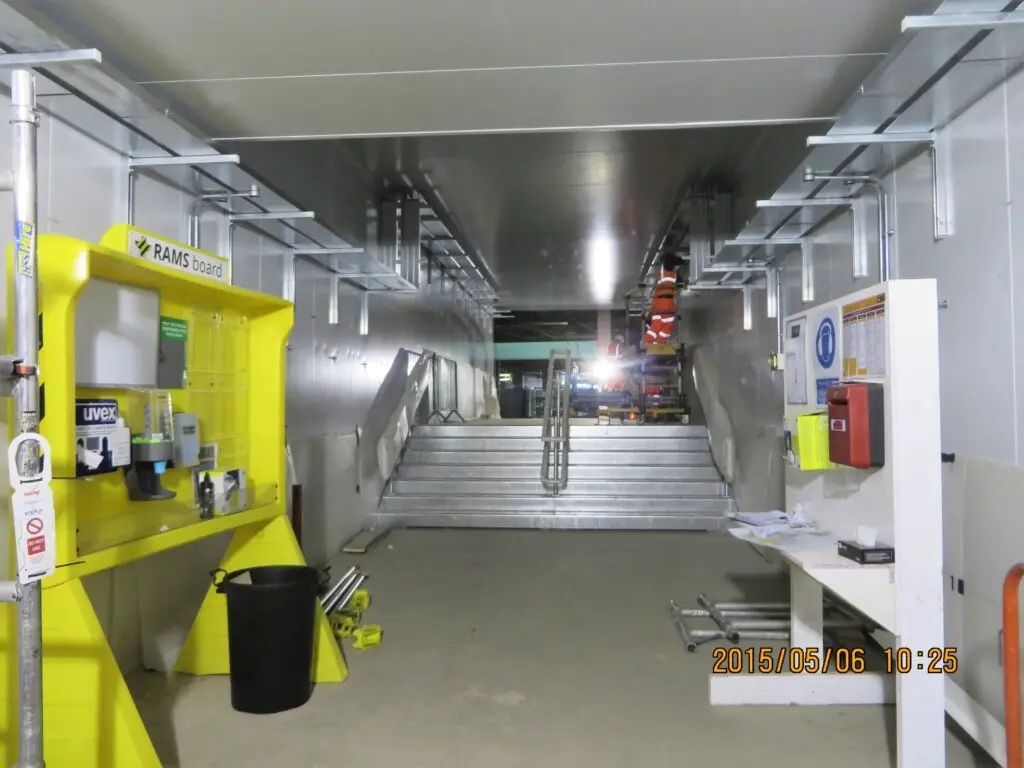
RAMS boards integrate solutions designed for the demanding conditions of construction sites. Made from high-density polyethylene (HDPE), they outperform standard materials such as Correx Plastic, Foamex or 3mm PVC in terms of durability, resistance to UV radiation, moisture and mechanical damage.
Compared to Correx, which is a lightweight ductile material made from polypropylene, HDPE offers significantly higher mechanical strength and resistance to stress cracking. Correx performs well in less demanding conditions, but its hollow-channel structure is prone to deformation under heavy use.
Foamex, made of rigid PVC foam, is a relatively weather-resistant material, but less impact-resistant than HDPE. HDPE not only withstands mechanical damage better, but also outperforms Foamex in terms of UV resistance, making it more suitable for long-term outdoor use.
HDPE material provides longevity and reliability in harsh weather conditions, while also being resistant to chemicals, further adding to its versatility and advantage over traditional materials used in building boards.
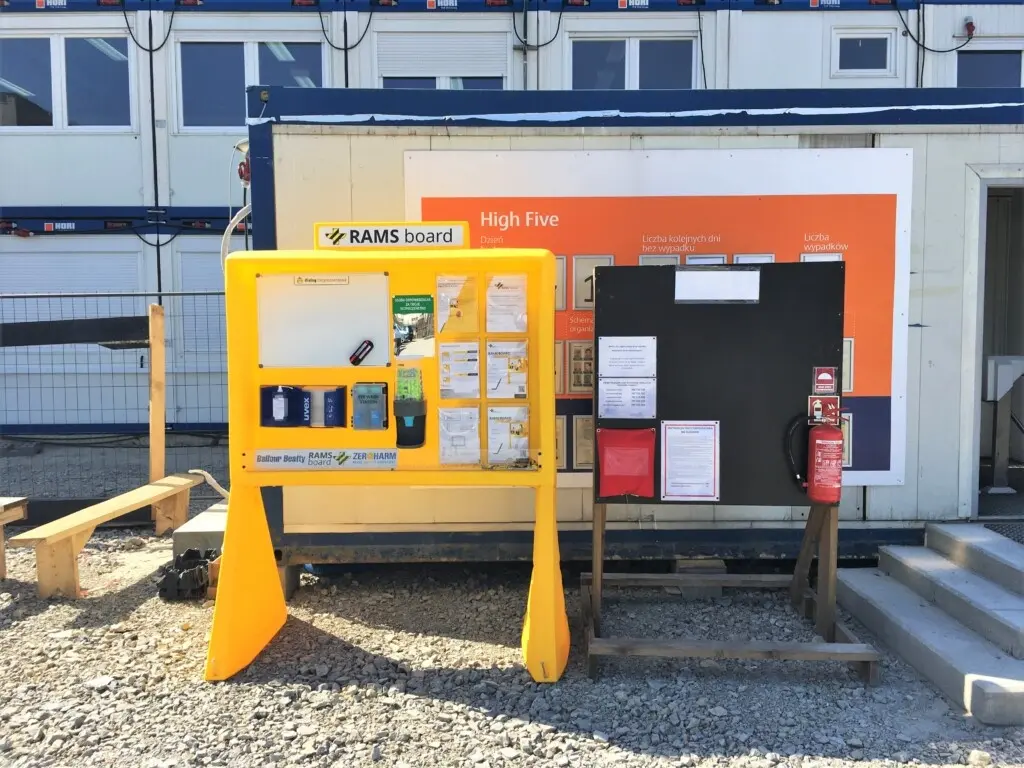
When it comes to RAMS whiteboard equipment, this includes dry erase boards, A4 and A3 document pockets, as well as functional extras such as eyewash stations, earplug receptacles and disinfectant fluid dispensers. These items support daily operations and emergency response, ensuring the health and safety of employees.
In addition, some models feature a mirror to help clear dust from the eyes and remind workers of their individual responsibility for safety. RAMS boards are mobile, allowing them to be easily transported and installed anywhere, adapting them to dynamic working conditions.
RAMS boards combine durability, functionality and practical design, offering comprehensive support in work organisation and safety. Thanks to their durability and advanced equipment, they are a key tool at every stage of a construction project.
Key Components of Construction Site Safety Boards
Construction site safety boards are essential tools for creating a secure and hazard-free work environment. They act as the central hub for all critical safety information, ensuring that both workers and visitors are well-informed about necessary precautions and procedures. These boards are carefully designed to include several key elements that collectively uphold safety standards and ensure regulatory compliance.
Among the most important components is the health and safety law poster, a legal requirement that outlines fundamental health and safety regulations. This ensures that every on-site activity complies with the law. Additionally, PPE safety signs serve as constant reminders to wear essential protective gear, such as helmets and gloves, emphasizing that safety starts with proper preparation.
Other critical elements include prohibition signs, which clearly define restricted actions like smoking or entering unauthorized areas, and warning signs, which alert individuals to potential hazards such as heavy machinery or slippery surfaces. Finally, mandatory signs highlight actions that must be taken—like wearing helmets or safety boots—to ensure everyone’s well-being.
As construction sites face evolving challenges, the question arises: how can these safety boards adapt to become even more effective in promoting safety and compliance?
Health and Safety Law Poster: Legal Requirements and Compliance
The Health and Safety Law Poster is the cornerstone of any construction site safety board. Far from being a mere formality, it is a legal necessity. This poster provides a clear and concise overview of British health and safety laws, ensuring that all site operations align with legal standards. It also symbolizes the site’s unwavering commitment to protecting everyone on the premises.
By prominently displaying this poster, construction sites send a strong message: safety and compliance are non-negotiable. It serves as a constant reminder for both workers and visitors to adhere to regulations, significantly reducing the likelihood of accidents. Its alignment with the Health and Safety (Safety Signs and Signals) Regulations 1996 further underscores its indispensable role in workplace safety.
As regulations evolve to address modern challenges, construction sites must explore innovative ways to ensure their safety boards remain both compliant and effective in communicating these legal requirements.
PPE Safety Signs: Ensuring Proper Protective Equipment Usage
PPE safety signs are a vital feature of construction site safety boards. Their primary purpose is to ensure that everyone understands the importance of personal protective equipment. Whether it’s helmets, gloves, or safety boots, these signs act as visual cues to gear up and stay protected.
By placing these signs in highly visible locations, construction sites reinforce the critical nature of safety protocols. These signs serve as quick, unmistakable reminders for workers to wear their protective gear before entering potentially hazardous zones. This not only minimizes risks but also fosters a culture where safety becomes second nature.
As construction environments grow increasingly complex, sites must consider innovative strategies to make PPE safety signs more noticeable and impactful, such as using digital displays or augmented reality.
Prohibition Signs: Highlighting Restricted Actions
Prohibition signs are the unmistakable “no-go” indicators on construction site safety boards. Their purpose is to clearly communicate which actions or areas are off-limits, such as smoking, unauthorized access, or other restricted activities. These signs play a crucial role in maintaining order and safety.
By clearly marking prohibited zones or behaviors, these signs deter risky actions and ensure adherence to safety protocols. Strategically placed for maximum visibility, they are a straightforward yet highly effective tool for keeping both workers and visitors out of harm’s way. A safer site is, after all, a more productive one.
As new risks emerge, construction sites must update prohibition signs to address the unique challenges of modern work environments, potentially incorporating dynamic or digital signage for greater adaptability.
Warning Signs: Identifying Potential Hazards
Warning signs are the unsung heroes of construction site safety boards. Their mission is to provide a clear alert about potential dangers, such as heavy machinery, slippery surfaces, or other site-specific risks. These signs are designed to make hazards impossible to overlook.
When strategically positioned, warning signs grab attention and prompt individuals to take necessary precautions. They are instrumental in fostering a safety-first mindset, encouraging both workers and visitors to remain vigilant. A simple warning can often prevent a major mishap.
To enhance their effectiveness, construction sites could explore cutting-edge technologies or design innovations, such as reflective materials, LED lighting, or even interactive warning systems.
Mandatory Signs: Indicating Required Actions
Mandatory signs are the “must-do” directives on construction site safety boards. Their role is to clearly communicate the actions everyone must take to ensure safety—whether it’s wearing helmets, safety boots, or other protective gear. These signs ensure that no one overlooks the essentials.
By explicitly stating required actions, mandatory signs foster a collective sense of responsibility. They serve as constant prompts to follow safety protocols, which not only prevent accidents but also nurture a culture of vigilance and teamwork. In essence, they are small but powerful tools in maintaining a secure work environment.
As safety standards advance, construction sites should consider reimagining mandatory signs to address the dynamic needs of modern environments, such as incorporating multilingual instructions or digital displays for greater accessibility.
Enhancing Safety Boards with Additional Features
Construction sites are bustling hubs of activity, where ensuring safety is a constant challenge. Upgrading safety boards with additional features is a smart way to enhance communication and keep everyone aligned. By incorporating elements like custom signs, these boards can be tailored to the specific needs of each site, ensuring that vital safety information is communicated clearly and effectively.
Features such as document holders and first aid points go beyond convenience—they ensure that critical resources are always within easy reach. This proactive approach minimizes risks, prevents accidents, and fosters a safer, more efficient work environment for everyone involved.
As construction sites evolve, the question arises: what innovative features can we introduce to make safety boards even more versatile and impactful?
First Aid Points: Emergency Response Essentials
First Aid Points are lifesaving additions to safety boards. These clearly designated sections house first aid kits and emergency contact details, ensuring that assistance is just moments away when it’s needed most. In emergencies, having these supplies and information readily accessible can mean the difference between a minor incident and a major crisis.
By prominently integrating first aid points into safety boards, construction sites enhance their emergency preparedness while ensuring compliance with health and safety regulations. This dual benefit not only protects workers but also demonstrates the site’s commitment to vigilance and readiness.
As safety standards advance, construction sites can explore cutting-edge first aid solutions to further elevate their emergency response capabilities.
Document Holders: Organizing Important Safety Documents
Document holders are indispensable for construction site safety boards. These holders keep essential safety documents—such as insurance certificates, safety policies, and compliance records—neatly organized and easily accessible. This eliminates the need for frantic searches when time is of the essence.
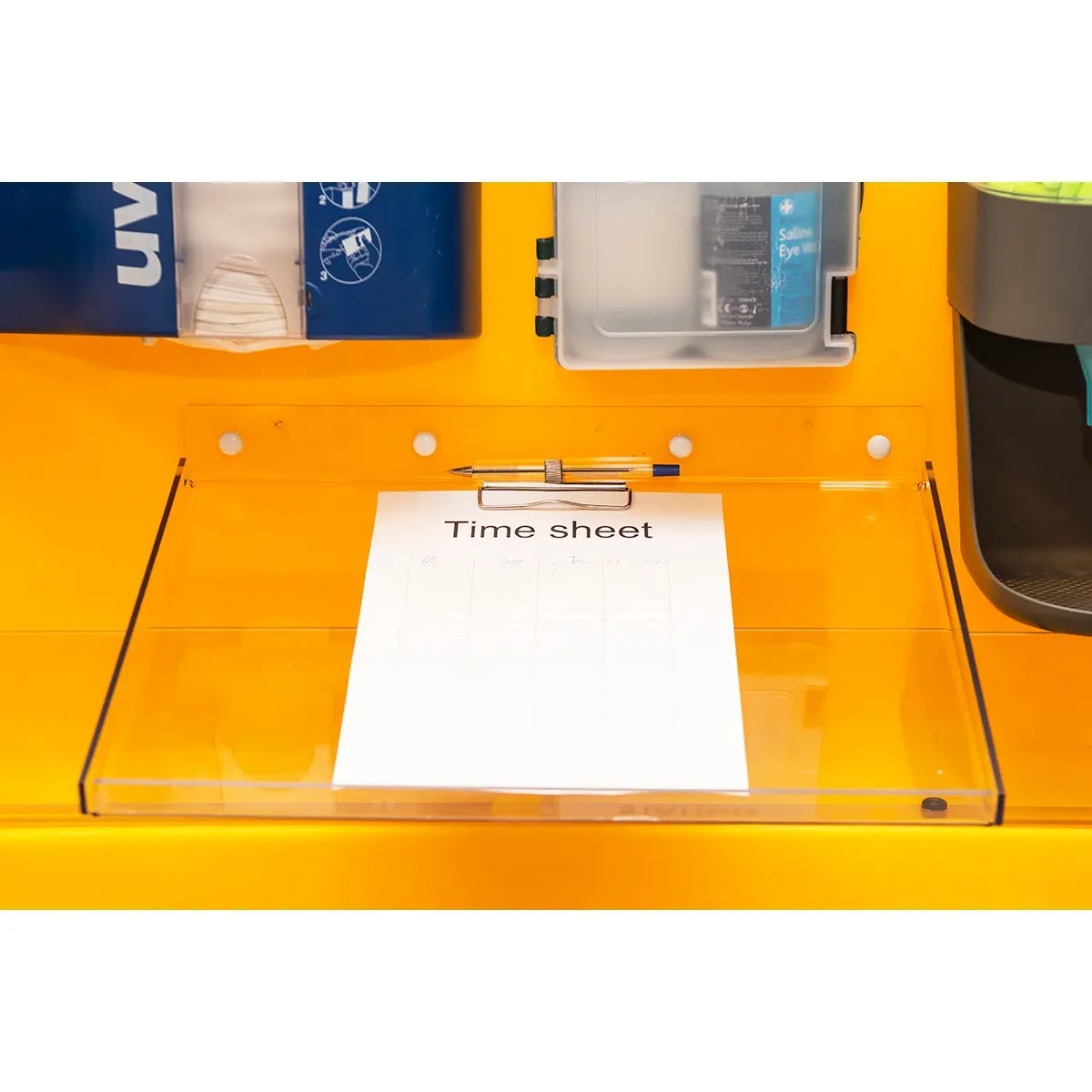
Incorporating document holders into safety boards streamlines the sharing of safety information, reduces miscommunication, and ensures that everyone on-site is well-informed. This efficient system saves time and fosters a culture where safety awareness and accountability are prioritized.
As construction projects grow more complex, reimagining document holders to accommodate the expanding variety and volume of safety documentation is a challenge worth addressing.
Site Traffic Signs: Managing Vehicle Movement Safely
Site traffic signs are critical for maintaining order on construction sites. These signs provide clear instructions and warnings to drivers, helping to regulate vehicle movement. The result? Fewer accidents and a more organized flow of traffic throughout the site.
Integrating site traffic signs into safety boards elevates traffic management by providing drivers with better awareness of designated routes and safety protocols. This not only safeguards workers and visitors but also ensures the site operates smoothly and efficiently.
With technology transforming construction sites, innovative tools and strategies can further enhance the effectiveness of site traffic signs, making them even more impactful.
Hand Sanitising Dispensers: Promoting Hygiene on Site
Hand sanitising dispensers have become essential components of construction site safety boards. These dispensers encourage regular hand hygiene, reducing the spread of germs and maintaining a healthier work environment.
By incorporating hand sanitising dispensers into safety boards, construction sites meet hygiene standards while demonstrating a commitment to the well-being of workers and visitors. This simple yet impactful addition promotes cleanliness and shared responsibility.
As hygiene expectations rise, construction sites can adopt innovative hygiene solutions to further enhance practices with tools like hand sanitising dispensers.
Materials and Design Considerations
Choosing the right materials for construction site safety boards is not just important—it’s essential. The focus should be on durability and sustainability. One standout material is Eco vinyl. This material is not only incredibly tough but also environmentally friendly. It thrives in extreme weather conditions while promoting green practices, making it a go-to choice for countless construction projects.
Another excellent option is Correx plastic, which strikes a perfect balance between sturdiness and low maintenance. Its wipe-clean surface ensures that safety messages remain clear and legible, even in the dirtiest environments. Additionally, aluminium composite offers a strong yet lightweight alternative, making it a practical and dependable choice for safety boards.
With sustainability becoming a cornerstone of modern construction, the question arises: how can we innovate further to incorporate even more eco-conscious materials into safety board designs?
Correx Plastic Material: Durability and Maintenance
Correx plastic is a premier choice for construction site safety boards due to its exceptional durability. This material is designed to withstand the harsh conditions commonly found on construction sites, making it a reliable option for boards exposed to the elements.
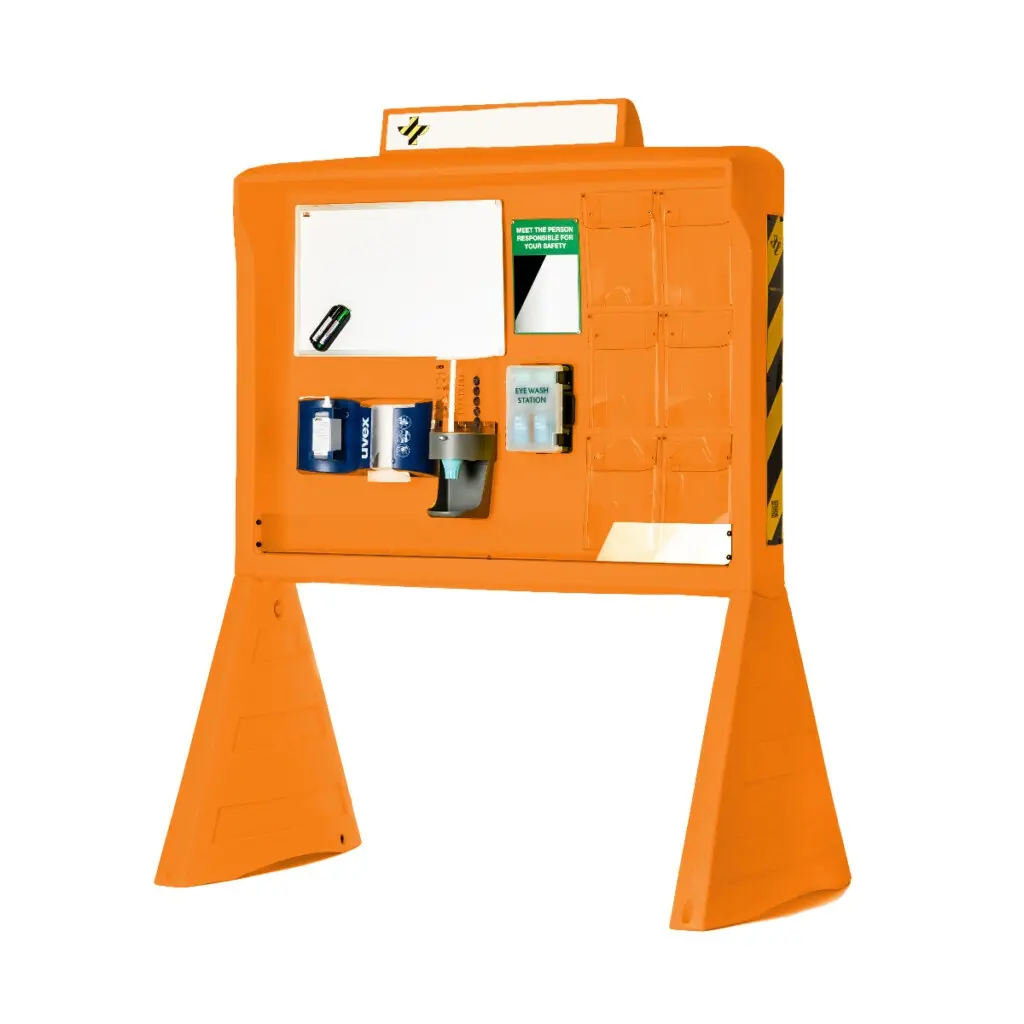
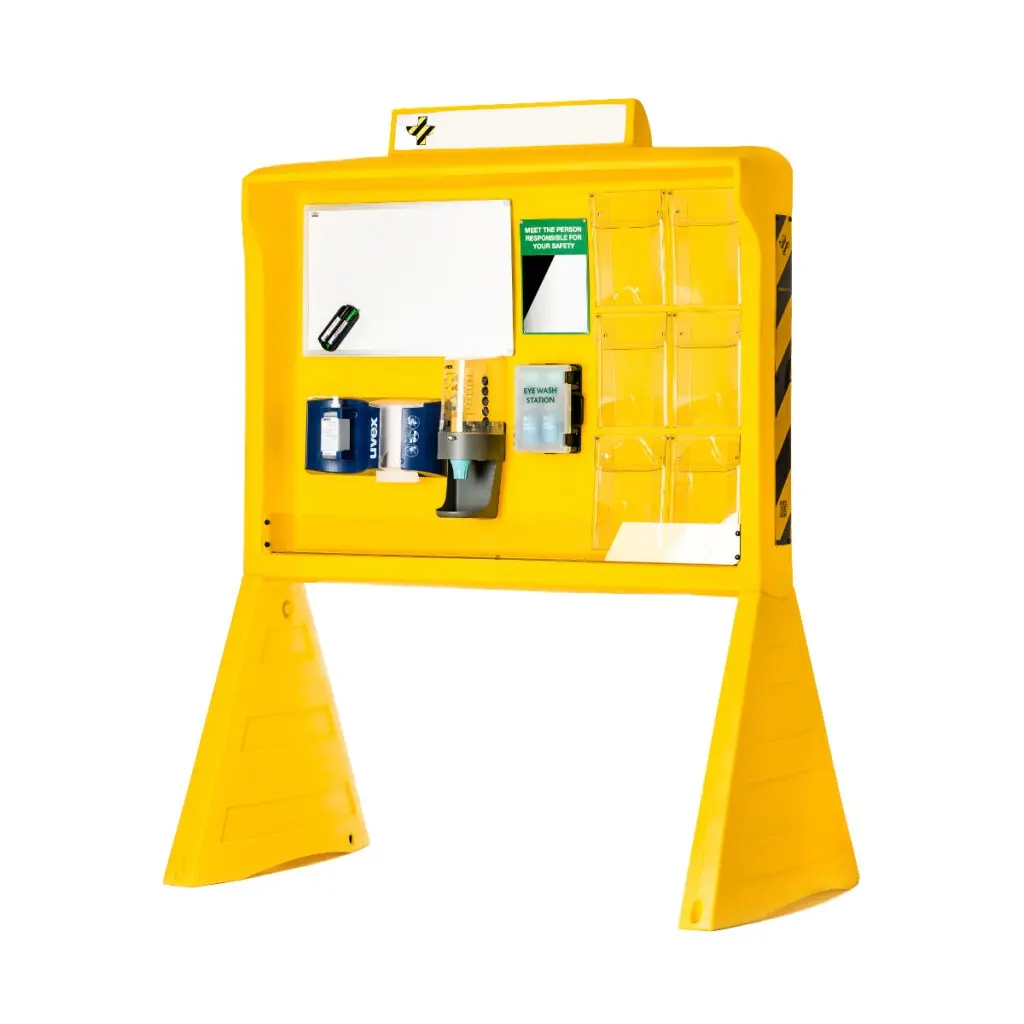
What truly sets Correx plastic apart is its wipe-clean surface. This feature ensures that safety messages remain sharp and readable, regardless of the surrounding mess. A quick wipe is all it takes to restore its clarity. Additionally, its lightweight nature simplifies installation and repositioning, making it ideal for dynamic, fast-paced work environments.
As the demand for durable, low-maintenance materials grows, the question remains: what groundbreaking advancements could elevate Correx plastic even further for safety applications?
Hinged Safety Boards: Portability and Storage Solutions
Hinged safety boards provide a smart and adaptable solution for construction sites that require flexibility and ease of transport. Thanks to their folding design, these boards are incredibly easy to store and relocate while maintaining the visibility of critical safety information.
Their portability is a game-changer. In fast-paced work environments where safety needs can shift rapidly, these boards can be folded and moved in moments. This ensures that essential safety messages are always accessible to workers and visitors, no matter where they are on-site.
As construction sites continue to evolve, one question remains: what innovative design tweaks could make hinged safety boards even more portable and storage-efficient?
Legal and Regulatory Compliance
In the construction industry, adhering to legal and regulatory standards is not just a formality—it forms the backbone of a secure and efficient work environment. The proper application of safety boards is guided by these meticulously designed rules, which aim to protect both workers and visitors. For site managers and safety officers, understanding these regulations is not merely advisable—it is essential for establishing and maintaining robust safety protocols.
Compliance with legal and regulatory requirements encompasses a wide range of responsibilities, from the precise placement of safety signs to conducting comprehensive risk assessments. However, it goes beyond simply ticking boxes. It is about fostering a culture of safety and accountability. By ensuring that all safety boards and signage meet prescribed standards, construction sites can significantly reduce accident risks while enhancing overall safety practices.
As the construction sector evolves, one pressing question remains: How can site managers anticipate regulatory changes to ensure their sites remain both compliant and secure?
Health and Safety (Safety Signs and Signals) Regulations 1996
The Health and Safety (Safety Signs and Signals) Regulations 1996 serve as the cornerstone for the effective use of safety signs on construction sites. These guidelines provide detailed instructions on the proper usage and placement of safety signs, ensuring that potential hazards and necessary precautions are communicated clearly to everyone on-site.
- Purpose: To ensure safety messages are clear and universally understood.
- Specifications: Types of signs, their design, and placement are clearly defined.
- Impact: Helps prevent accidents and ensures legal compliance.
Complying with these regulations is not just about avoiding legal repercussions—it is about fostering a safer workplace. By adhering to the 1996 regulations, construction sites can refine their safety communication strategies, making it easier for workers and visitors to follow safety protocols.
As safety standards continue to advance, a thought-provoking question arises: How can emerging technologies or innovative designs further enhance the effectiveness of safety signs?
Management of Health and Safety at Work Regulations 1999
The Management of Health and Safety at Work Regulations 1999 emphasize the critical role of risk assessment and accountability in workplace safety. These regulations mandate that employers conduct thorough risk assessments to identify potential hazards and implement measures to mitigate them. This proactive approach is pivotal in preventing accidents and fostering a secure work environment.
- Risk Assessment: Employers must identify and mitigate potential hazards.
- Worker Awareness: Ensures workers are informed about risks and precautions.
- Training and Resources: Adequate training and access to safety resources are required.
By adhering to the 1999 regulations, construction sites can nurture a culture of safety and shared responsibility, where everyone understands their role in maintaining a safe workplace. As the industry confronts new challenges, a key question emerges: How can risk assessment techniques evolve to address emerging safety concerns effectively?
ISO 7010 Compliance: Standardized Safety Symbols
Adhering to ISO 7010 is crucial for ensuring that safety symbols on construction site boards are standardized and easily recognizable. This international standard provides clear guidelines for the design and use of safety symbols, promoting consistency and clarity in safety communication.
- Standardization: Ensures safety symbols are universally recognizable.
- Global Relevance: Bridges language and cultural barriers in diverse workplaces.
- Enhanced Communication: Improves safety messaging for workers and visitors alike.
Compliance with ISO 7010 enhances the effectiveness of safety boards by making their messages universally comprehensible. This standardization is particularly vital in diverse workplaces where language barriers may exist, ensuring that safety symbols are understood regardless of language or cultural differences.
As construction sites become increasingly global, an intriguing question arises: How can the industry leverage ISO 7010 compliance to bridge cultural and linguistic divides, thereby improving safety communication on a worldwide scale?
Implementing and Maintaining Safety Boards
Setting up and maintaining safety boards on construction sites is not merely a formality—it is a critical component of fostering a secure and compliant work environment. These boards serve as the heartbeat of safety communication, requiring constant updates to reflect the latest protocols and site-specific risks. When kept relevant and up-to-date, they become indispensable tools for disseminating critical information and ensuring adherence to health and safety regulations.
To maintain the effectiveness of safety boards, the information displayed must be both accurate and current. This requires regular reviews and updates to incorporate new safety procedures, regulatory changes, or emerging on-site hazards. Engaging workers and safety officers in this process can be transformative, as their firsthand insights often uncover overlooked gaps, enhancing the boards’ role in promoting a strong safety culture.
As construction sites evolve with new challenges and technologies, a key question arises: How can advancements be leveraged to simplify the implementation and upkeep of safety boards while ensuring they remain central to site safety management?
Risk Assessment Process: Determining Safety Board Placement
The risk assessment process is essential in determining the optimal placement of safety boards on a construction site. This process involves a thorough evaluation of potential hazards and identifying locations where these boards will have the greatest impact. Strategically placing them in high-risk zones ensures that critical safety messages are effectively communicated, thereby reducing the likelihood of accidents.
A comprehensive risk assessment includes the following steps:
- Identifying potential hazards: Pinpoint areas and activities that pose risks to workers and visitors.
- Assessing the risks: Evaluate the severity and likelihood of these hazards causing harm.
- Devising mitigation strategies: Implement measures to reduce or eliminate risks, including the strategic placement of safety boards.
These steps not only protect workers and visitors but also ensure compliance with key regulations, such as the Health and Safety (Safety Signs and Signals) Regulations 1996 and the Management of Health and Safety at Work Regulations 1999. These laws emphasize the importance of clear and effective safety signage in maintaining a secure work environment.
As construction projects grow more complex, another pressing question emerges: How can the risk assessment process be refined to optimize safety board placement and align with evolving safety standards?
Best Practices for Updating and Maintaining Safety Boards
Following best practices for updating and maintaining safety boards is vital to preserving their role as effective safety communication tools. Regular inspections and timely updates are the foundation of ensuring these boards remain relevant and compliant with current safety standards.
Key practices to consider include:
- Conduct routine inspections: Identify and address any damage, wear, or obstructions that could compromise the boards’ visibility or readability.
- Ensure cleanliness and visibility: Keep all signs clean, intact, and prominently displayed to maximize their impact.
- Update promptly: Reflect changes in safety protocols or site-specific risks as soon as they arise.
Feedback from workers and safety officers is invaluable. These individuals interact with the boards daily, and their observations can highlight areas for improvement, ensuring the boards meet the practical needs of the workforce.
As safety standards continue to evolve, the challenge lies in discovering innovative methods to keep safety boards updated and impactful. What new strategies can be implemented to ensure these boards remain a cornerstone of site safety management?
Specialized Safety Boards for Specific Needs
Construction site safety is never a one-size-fits-all solution. That’s why specialized safety boards are designed to address unique challenges, ensuring workers remain informed and protected. These boards are meticulously crafted to deliver precise information and resources, fortifying the safety framework on any construction site.
Site Safety Notice Board with Manual Handling Information
The Site Safety Notice Board with Manual Handling Information transforms how safe lifting practices are promoted on construction sites. These boards provide clear, actionable guidance on proper manual handling techniques, significantly reducing injuries caused by improper lifting. By presenting the content in an easy-to-understand format, they empower workers to adopt safer habits, fostering a safety-first culture.
- Focus on manual handling: These boards are tailored for environments where heavy lifting is routine, emphasizing the importance of correct techniques.
- Injury prevention: By promoting proper lifting practices, they help reduce workplace injuries.
- Encouraging ownership: Workers are motivated to take responsibility for their well-being.
Construction sites are ever-changing. So, here’s a question to consider: how can we innovate manual handling boards to address emerging challenges and elevate worker safety even further?
Lost Days Accident Reporting Boards: Tracking Workplace Incidents
Lost Days Accident Reporting Boards are essential tools for monitoring workplace incidents and recording the number of workdays lost due to accidents. These boards serve as a constant visual reminder, underscoring the importance of safety while fostering accountability and awareness.
- Incident tracking: They help identify patterns and high-risk areas, enabling targeted safety measures.
- Promoting accountability: Their prominent placement encourages a proactive safety mindset among workers and managers.
- Driving improvement: By highlighting workplace incidents, they inspire continuous safety enhancements.
In an industry where safety is paramount, here’s something to consider: what innovative approaches could make accident reporting boards even more impactful in reducing workplace incidents?
Construction Safety Notice Boards with Deep Capacity Holders
The Construction Safety Notice Boards with Deep Capacity Holders are a game-changer for organizing and accessing safety documents. With their deep capacity holders, these boards ensure that vital safety materials are always within easy reach for both workers and visitors.
- Enhanced organization: They simplify the storage and retrieval of critical safety information.
- Regulatory compliance: By keeping safety documents accessible, they help maintain compliance with safety regulations.
- Maximized functionality: Their thoughtful design ensures tidiness and efficiency, even in busy construction environments.
As construction projects grow in complexity, here’s a thought to ponder: how can we refine the design of deep capacity holders to accommodate even more safety materials while ensuring effortless access?
Conclusion: Prioritizing Safety with Effective Site Safety Boards
Construction sites are inherently unpredictable environments. This is precisely why site safety boards are not just a luxury—they are an absolute necessity. These boards act as the foundation of a secure work environment by presenting critical safety information and rules in a clear and accessible way. Their purpose is to ensure that everyone, from workers to visitors, remains informed about essential safety protocols. The benefits? Fewer accidents, improved teamwork, and a shared sense of accountability across all site participants.
In the dynamic and high-pressure world of construction, safety boards serve as a reliable guide. They provide a constant reminder to uphold safety standards and adhere to regulations, ensuring that everyone stays alert and focused. When safety is prioritized through clear and consistent communication, the risk of accidents significantly decreases. The outcome is not just a safer worksite but also a more efficient and productive one.
So, what’s the next step? How can construction sites continue to innovate and enhance safety measures to ensure that every individual stepping onto the site is protected? The future of site safety holds immense potential. It is up to us to adopt smarter, more effective solutions and continuously raise the standards for safety and well-being.
